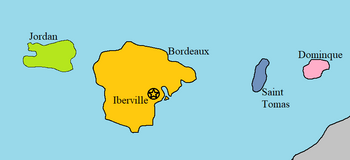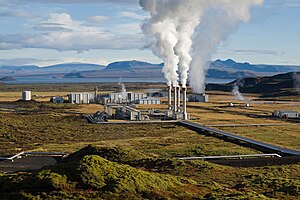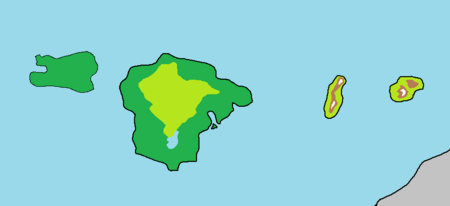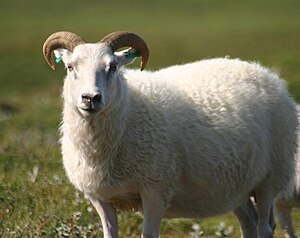Merona
The Merona Republic | |
|---|---|
|
Flag | |
| Motto: "The falcon cannot hear the falconer" | |
 The Main Islands of Merona | |
| Capital | Iberville |
| Recognised national languages | English, French |
| Demonym(s) | Meronan |
| Government | Presidential Unitary Republic |
| Lee Wilkinson | |
• Vice President | Stephania Beaufort |
• Speaker of the Assembly | Dominick Garret |
| Legislature | National Assembly |
| Establishment | |
• Establishment of Merona Colony | August 13, 1495 |
• Kingdom of Merona established | April 3, 1560 |
• Republic established | February 26, 1734 |
| Area | |
• Total | 8,516 km2 (3,288 sq mi) |
| Population | |
• 2019 estimate | 2,342,530 |
| GDP (PPP) | 2015 estimate |
• Total | $54,769 |
| GDP (nominal) | estimate |
• Total | $128,300,000,000 |
| HDI (2015) | .893 very high |
| Currency | Ibican Dollar (ID) |
| Date format | mm-dd-yyyy |
| Driving side | right |
| Calling code | +2 |
| Internet TLD | .mr, .mer |
The Merona Republic, commonly referred to as just Merona, is a Unitary republic consisting of 4 main islands and a population of 2,342,530. The islands are located in the northeastern Cortesia Ocean. Iberville is the capital and largest city.
The islands of Merona were colonized by the Kingdom of Cartier in 1495, with the establishment of Lourdes on Jordan Island. The islands were entirely uninhabited prior to their discovery by Royal Navy Captian Grégory Fournier. Jordan and Bordeaux Islands were primarily used for the cultivation of sugar and raising cattle and sheep. The more mountainous islands of Dominique and Saint Tomas were larger undeveloped aside from limited mining of silver and coal on Saint Tomas. After the fall of Cartier, the royal family relocated to Iberville and declared the Kingdom of Merona. A violent coup in 1620 saw the deposition of the royal family
Today Merona has a diversified economy focusing on resource extraction, financial services, and tourism.
Geography
Geology


Merona has many geysers, including and the famous Vieux Fiable, which erupts every 8–10 minutes. With the widespread availability of geothermal power, and the harnessing of many rivers and waterfalls for hydroelectricity, most residents have access to inexpensive hot water, heating, and electricity. The islands are composed primarily of basalt, a low-silica lava associated with effusive volcanism. Merona, however, has a variety of volcanic types (composite and fissure), many producing more evolved lavas such as rhyolite and andesite. All of the volcanoes that formed the Merona chain have since gone dormant.
The highest elevation for Merona is listed as 2,110 m (6,923 ft) on Île Dominique.
Climate
The climate of Meronas's coast is subarctic. The warm Cortesia Nor'Eastern Current ensures generally higher annual temperatures than in most places of similar latitude in the world. Despite its proximity to the Arctic, the islands' coasts remain ice-free through the winter.
The climate varies between different parts of the islands. Generally speaking, the south coasts are warmer, wetter, and windier than the north. The Central Highlands of the smaller islands are the coldest part of the country. Low-lying inland areas on the western islands are the most arid.
The highest air temperature recorded was 30.5 °C (86.9 °F) on 22 June 1939 on the southeastern coast of Île Bordeaux. The lowest was −38 °C (−36.4 °F) on 22 January 1918 in the highlands of Île Dominique.
Animals
The only native land mammal when humans arrived was the Arctic fox, which came to the islands at the end of the ice age, walking over the frozen sea. On rare occasions, bats have been carried to the islands with the winds, but they are not able to breed there. Polar bears occasionally come over the ice as well, but they are just visitors, and no native populations exist. No native or free-living reptiles or amphibians are on the islands.
The animals of Merona include sheep, cattle, chickens, goats, the sturdy Merona horse, and the Merona Sheepdog, all descendants of animals imported by Ibicans. Wild mammals include the Arctic fox, mink, mice, rats, rabbits, and reindeer. Polar bears occasionally visit the islands, travelling on icebergs. In June 2008, two polar bears arrived in the same month. Marine mammals include the grey seal (Halichoerus grypus) and harbor seal (Phoca vitulina).
Many species of fish live in the ocean waters surrounding Merona, and the fishing industry is a major part of Merona's economy, accounting for roughly half of the country's total exports. Birds, especially seabirds, are an important part of Merona's animal life. Puffins, skuas, and kittiwakes nest on its sea cliffs.
Politics
Merona has a left–right two party system. Following the 2017 Assembly election, the Conservative Party is currently in power. Other political parties with seats in the National Assembly of Merona are the Progressive Party, the Green Party, and the Socialist Party.
Government
Merona is a representative democracy and a Presidential republic. The modern Assembly was founded in 1545 as an advisory body to the monarchy. It currently has 156 members, elected for a maximum period of four years.
The head of government is the President who, together with the cabinet, is responsible for executive government.
The president is elected by popular vote for a term of four years with no term limit. The elections for president, the Assembly, and local county and municipal councils are all held separately every four years. The current president is Lee Wilkinson.
The cabinet is appointed by the President after their election, or as vacancies arise. The President serves as both the head of state and head of government, while also serving as the commander-in-chief of the Merona Armed Forces. The Cabinet consists of the heads of the executive departments.
Administrative divisions
Merona is divided into counties and municipalities. The four counties are contiguous with their respective islands, and provide general services for unincorporated areas of their islands. Counties also have Sheriff's Departments that have general law enforcement jurisdiction over all areas of their islands. District court jurisdictions are also based on counties, with each county having at least one court district in it.
18 municipalities in Merona govern local matters like transport and zoning. These are the second-level subdivisions of Merona. Iberville is by far the most populous municipality, about twice the size of Norfolk, the second one.
Foreign relations
Due to it's tied history with Ibica, the two nations enjoy a special relationship, with much cooperation between their governments and military. Elsewhere, Merona seeks friendly relations with all nations, and hosts many embassies.
Military
Merona does not have much of a standing army, but does have the Merona Coast Guard, Merona Air Defense Corps, and the Merona Army. The Merona Defense Force (MDF) is a military command of the Ibican Armed Forces that was formed in 1923. The MDF came into existence when Ibica signed an agreement to provide for the defense of Merona. The MDF also consisted of civilian and military Meronans. Ibica currents has 25 Aegis A-18 Super Hornets stationed at Naval Base Norfolk in Bordeaux County, which is also the home port of the INS Mobile Aircraft Carrier and its strike group. Members of the Merona Armed Forces also receive training the Ibican Military Service Academies.
Economy
About 85 percent of total primary energy supply in Merona is derived from domestically produced renewable energy sources. Use of abundant hydroelectric and geothermal power has made Merona the world's largest electricity producer per capita. As a result of its commitment to renewable energy, the 2016 Global Green Economy Index ranked Merona among the top 10 greenest economies in the world. Historically, Merona's economy depended heavily on fishing, which still provides 20% of export earnings and employs 7% of the workforce. The economy is vulnerable to declining fish stocks and drops in world prices for its main material exports: fish and fish products, aluminium, and ferrosilicon. Merona still relies heavily on fishing and farming, but its importance is diminishing from an export share of 70% in the 1960s to 30% in 2006.
Until the 20th century, Merona was a fairly poor country. Currently, it remains one of the most developed countries in the world. Based on the Gini coefficient, Merona also has one of the lowest rates of income inequality in the world.
Merona's economy has been diversifying into manufacturing and service industries in the last decade, including software production, biotechnology, and finance; industry accounts for around a quarter of economic activity, while services comprise close to 70%. The tourism sector is expanding, especially in ecotourism and whale-watching. On average, Merona receives around 1.1 million visitors annually, which is half the native population. Merona's agriculture industry, accounting for 5.4% of GDP, consists mainly of potatoes, green vegetables (in greenhouses), mutton and dairy products.
Transport
Merona has a high level of car ownership per capita; with a car for every 1.5 inhabitants; it is the main form of transport. Merona has 13,034 km (8,099 mi) of administered roads, of which 4,617 km (2,869 mi) are paved and 8,338 km (5,181 mi) are not. A great number of roads remain unpaved, mostly little-used rural roads.
The highway network of Merona consists of the disjointed County Route systems. These systems very considerably, with Bordeaux County Highways maintaining several controlled access freeways, and Dominique County Routes consisting only of two lane roads, most of which are unpaved.
Iberville International Airport (IIA) is the largest airport and the main aviation hub for international passenger transport. It serves several international and domestic airline companies. IIA is in the vicinity of the larger metropolitan capital area, midway between Iberville and Norfolk, on the Bordeaux County Highway 1 freeway, with mass transit connections to most cities on the island.
The only railways in Merona are on Île Bordeaux, consisting of commercial freight rail, and light passenger rail operated by the Bordeaux Transit Authority.
The Merona Marine Highway is a system of car and passenger ferries connecting the islands, typically connecting to Highway 1 on each island, to give the appearance of one continuous highway running west to east across the entire country.
Energy

Renewable sources—geothermal and hydropower—provide effectively all of Merona's electricity and around 85% of the nation's total primary energy consumption, with most of the remainder consisting of oil products used in transportation and in the fishing fleet. A 2000 report from the University of Merona suggested that Merona could potentially convert from oil to hydrogen power by 2040. Merona is one of the few countries that have filling stations dispensing hydrogen fuel for cars powered by fuel cells. It is also one of a few countries currently capable of producing hydrogen in adequate quantities at a reasonable cost, because of Merona's plentiful renewable sources of energy.
Education and science
The Merona Department of Science and Education is responsible for the policies and methods that schools must use, and they issue the National Curriculum Guidelines. However, playschools, primary schools, and lower secondary schools are funded and administered by the counties. The government does allow citizens to home educate their children, however under a very strict set of demands. Students must adhere closely to the government mandated curriculum, and the parent teaching must acquire a government approved teaching certificate.
Nursery school is non-compulsory education for children younger than six years, and is the first step in the education system. The current legislation concerning playschools was passed in 1994. They are also responsible for ensuring that the curriculum is suitable so as to make the transition into compulsory education as easy as possible.
Compulsory education comprises primary and lower secondary education, which often is conducted at the same institution. Education is mandatory by law for children aged from 6 to 16 years. The school year lasts nine months, beginning between August 21 and September 1, ending between May 31 and June 10. The minimum number of school days was once 170, but after a new teachers' wage contract, it increased to 180. Lessons take place five days a week. All public schools have mandatory education in Christianity, although an exemption may be considered by the Superintendent of Schools for the county.
Upper secondary education follows lower secondary education. Though not compulsory, everyone who has had a compulsory education has the right to upper secondary education. This stage of education is governed by the Upper Secondary School Act of 1996. All schools in Merona are mixed sex schools. The largest seat of higher education is the University of Merona, which has its main campus in central Iberville. Other schools offering university-level instruction include Norfolk University, University of Lourdes, and Merona Agricultural and Mechanical University.



